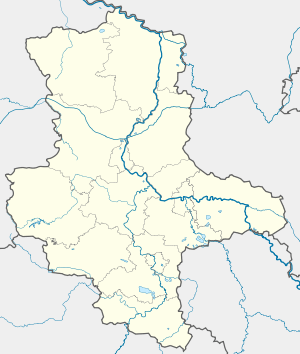Dessau-Roßlau
![]()
Dessau-Roßlau | |
|---|---|
 View over Dessau. | |
 Coat of arms | |
Location of Dessau-Roßlau 
| |
 Dessau-Roßlau  Dessau-Roßlau | |
| Coordinates: 51°50′N 12°15′E | |
| Country | Germany |
| State | Saxony-Anhalt |
| District | Urban district |
| Government | |
| • Lord Mayor | Peter Kuras |
| • Governing parties | Christian Democratic Union / The Left / Social Democratic Party of Germany |
| Area | |
| • Total | 244.62 km2 (94.45 sq mi) |
| Elevation | 61 m (200 ft) |
| Population (2018-12-31)[1] | |
| • Total | 81,237 |
| • Density | 330/km2 (860/sq mi) |
| Time zone | CET/CEST (UTC+1/+2) |
| Postal codes | 06811-06849 06861 06862 |
| Dialling codes | 0340 (Dessau) 034901(Roßlau) |
| Vehicle registration | DE, RSL |
| Website | www.dessau-rosslau.de |
Dessau-Roßlau is the third largest town of Saxony-Anhalt by population, after Magdeburg and Halle.
Dessau
Dessau is the largest population centre within Dessau-Roßlau, with approximately 77,000 inhabitants (2006). Most of the town is located on the left bank of the Mulde, south of its confluence with the Elbe. Dessau was first mentioned in 1213, and became the capital of a small state (Anhalt-Dessau) in the 14th century. Between 1863 and 1918, it was the capital of Anhalt. Since the second half of the 19th century, Dessau has been an industrial town. With the famous art and architecture school Bauhaus, located in Dessau between 1925 and 1932, and the Dessau-Wörlitz Garden Realm the town features two UNESCO World Heritage Sites. The town could be referred to as the one of the birthplaces of the "jet age" because the Junkers factory that designed the Jumo 004 jet engine for the German Me 262 jet fighter (operational from mid-1944) was designed there. Because the western shore of the Elbe-Mulde rivers was the stopping point for U.S. troops in World War II, the capture of the town allowed the U.S. Army to evacuate the Junkers people towards the west before the Russians took over occupation of the area on 1 July 1945. A number of principals of the jet engine development team at Junkers ended up at the Lycoming engine plant in Stratford, Conn. building gas turbine engines for the U.S. Army from 1952 on.
Roßlau
Roßlau has approximately 13,000 inhabitants (2006). It is located on the right bank of the Elbe, near its confluence with the Mulde, about 7 kilometers north of the centre of Dessau. Roßlau was first mentioned in 1215. Before it merged with Dessau, it was part of the district Anhalt-Zerbst.
Governance
Municipal assembly
Seats in the municipal assembly (Stadtrat) as of 2007 elections:
- Christian Democratic Union (CDU): 13
- The Left: 10
- Social Democratic Party of Germany (SPD): 8
- Pro Dessau-Roßlau (independent): 5
- Free Democratic Party (FDP): 4
- Bürgerliste (independent): 3
- New Forum: 3
- Alliance '90/The Greens: 2
- Free Voters: 1
- German People's Union (DVU): 1
plus the mayor
Town twinning
Dessau-Roßlau is twinned with:







References
- "Bevölkerung der Gemeinden – Stand: 31. Dezember 2018" (PDF). Statistisches Landesamt Sachsen-Anhalt (in German).